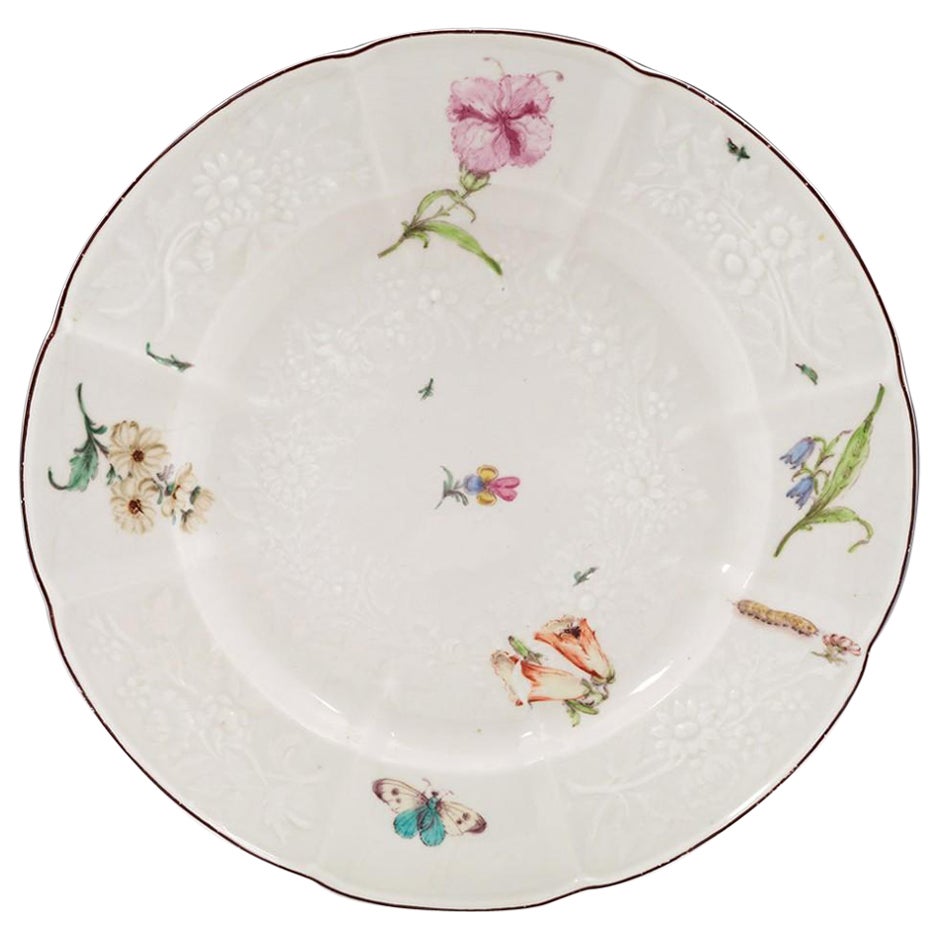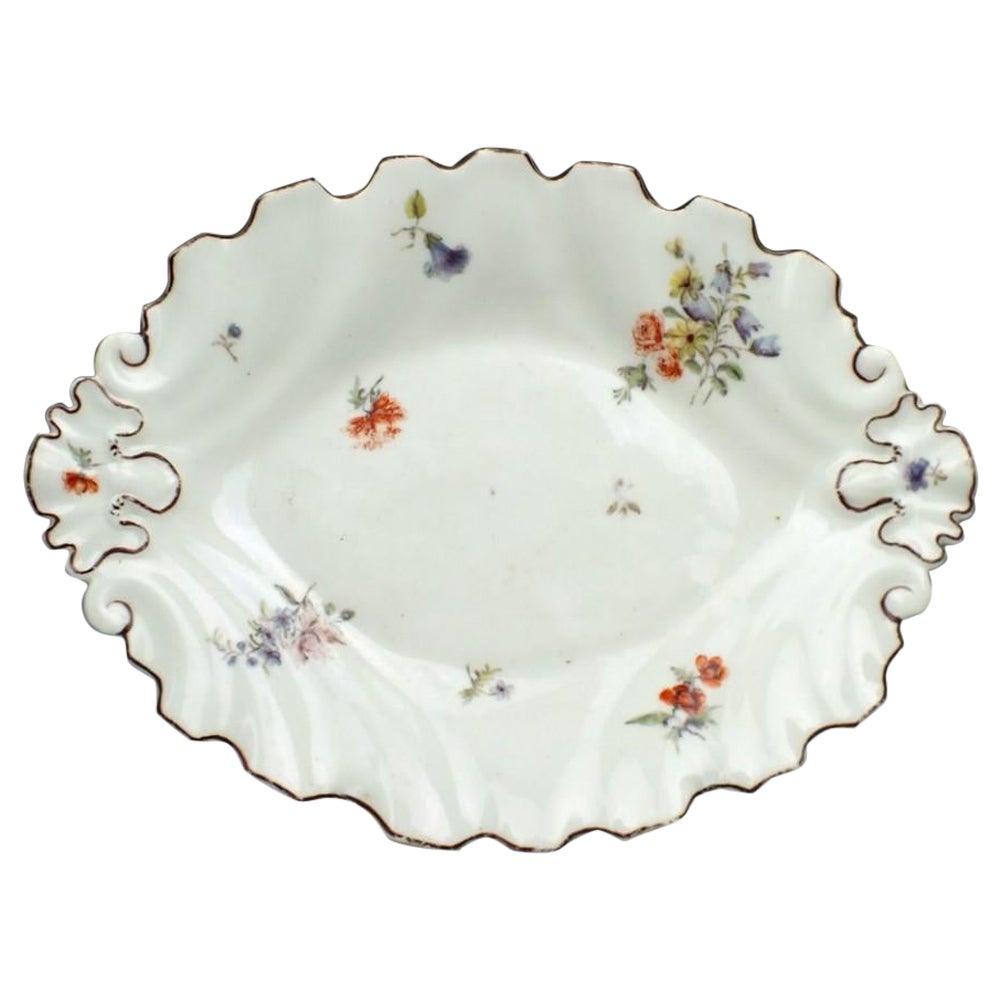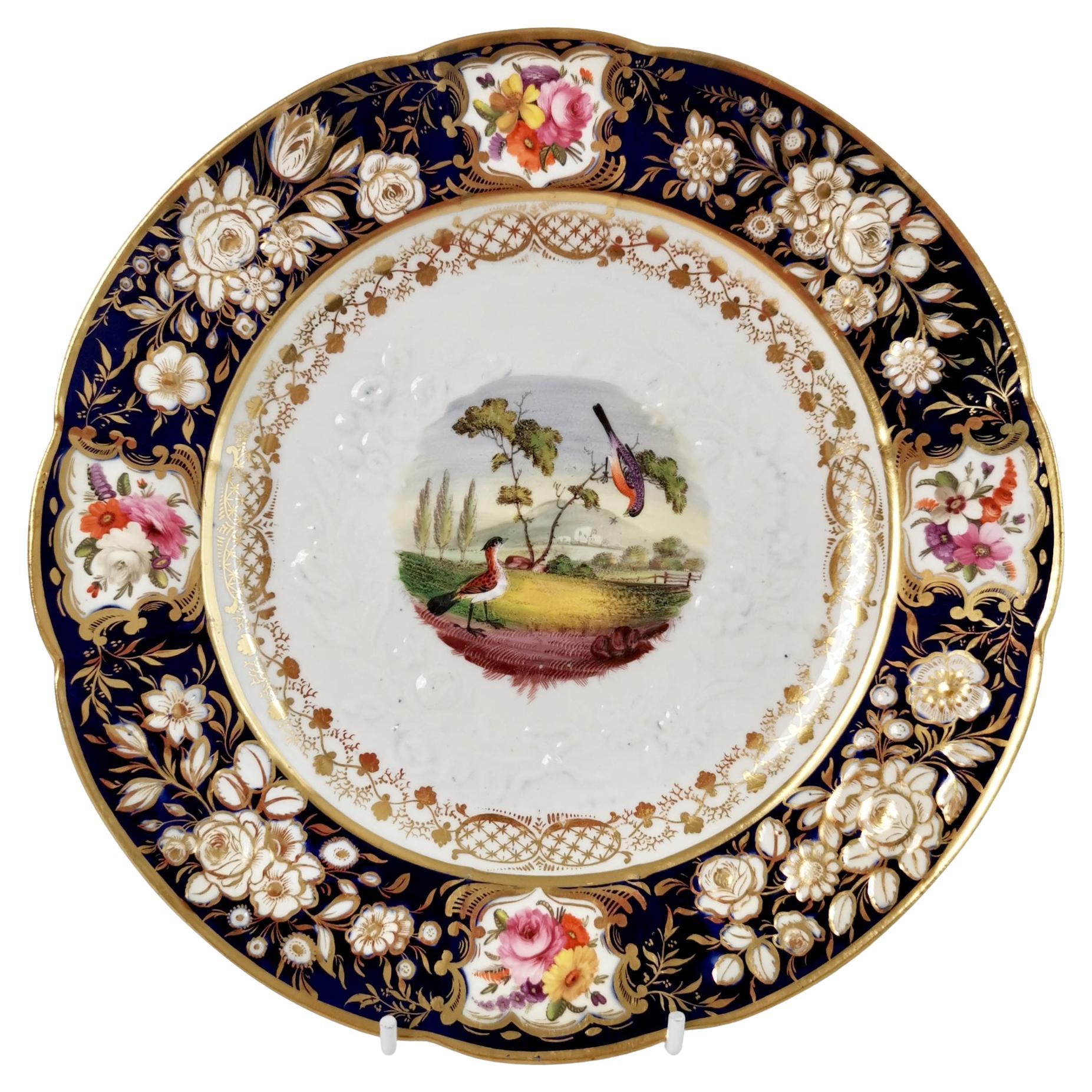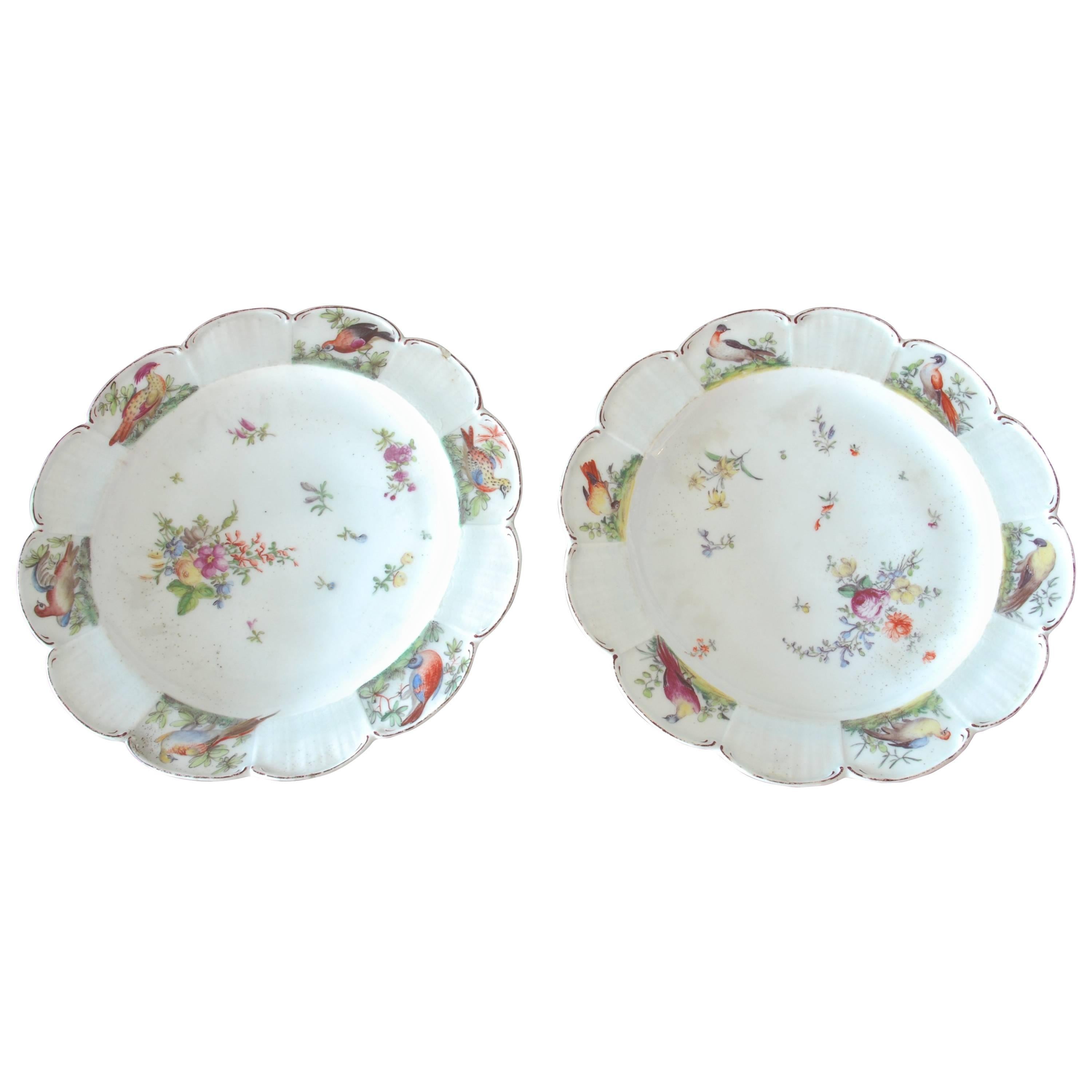Items Similar to Chelsea Plate, Feather Moulded with Flowers, Red Anchor Mark, ca 1755
Want more images or videos?
Request additional images or videos from the seller
1 of 11
Chelsea Plate, Feather Moulded with Flowers, Red Anchor Mark, ca 1755
About the Item
This is a beautiful plate made by Chelsea in circa 1755, which is known as the "Red Anchor" period of the factory.
Chelsea was one of the very early adopters of porcelain in the British china industry. Founded in 1744 the Chelsea pottery was for about 40 years the leading maker of fine chinaware, excelling in their sense of style, perfection and constant innovation and inspiring many following generations of china makers.
The company was started by French silversmith Nicholas Sprimont and you can see the influence of the French style of silverware in the shape of this feather-moulded plate, which was taken from an previous version in silver that Sprimont made early in his career.
Chelsea items are very rare as production levels were still low at the time and of course many items simply have not survived. The Chelsea pottery was only in production for about 30 years, which further adds to the scarceness of the items; it is rare to come across Chelsea items.
The plate is moulded in the "feathered" shape with fine feather-like shapes on the rim that have been picked out in puce and aquamarine green. This shape was inspired by the silver items that Nicholas Sprimont would have designed previously. There are very finely painted wild flowers dotted all over the plate; these are not placed in planned locations, but where ever there was a blemish to hide, as was usual at the time. This creates a very playful and spontaneous effect that would be impossible to design in a planned manner.
This plate is marked with a red anchor mark, which dates it between 1753 and 1758. It also has a "Falcon House Collection" label, presumably of the collection it previously belonged to.
Condition report: The plate is in perfect antique condition without any damage, repairs, crazing or significant wear. It has a little area of scraping under the glaze of the rim (see last picture), which happened during production.
Antique British porcelain is never perfect. Kilns were fired on coal in the 1800s, and this meant that china from that period can have some firing specks from flying particles. British makers were also known for their experimentation, and sometimes this resulted in technically imperfect results. Due to the shrinkage in the kiln, items can have small firing lines or develop crazing over time, which should not be seen as damage but as an imperfection of the maker's recipes, probably unknown at the time of making. Items have often been used for many years and can have normal signs of wear, and gilt can have signs of slight disintegration even if never handled. I will reflect any damage, repairs, obvious stress marks, crazing or heavy wear in the item description but some minor scratches, nicks, stains and gilt disintegration can be normal for vintage items and need to be taken into account.
There is widespread confusion on the internet about the difference between chips and nicks, or hairlines and cracks. I will reflect any damage as truthfully as I can, i.e. a nick is a tiny bit of damage smaller than 1mm and a chip is something you can easily see with the eye; a glazing line is a break in the glazing only; hairline is extremely tight and/or superficial and not picked up by the finger; and a crack is obvious both to the eye and the finger. Etcetera - I try to be as accurate as I can and please feel free to ask questions or request more detailed pictures!
Dimensions: 21.5cm (8.5").
- Creator:Chelsea Porcelain (Maker)
- Dimensions:Height: 0.5 in (1.27 cm)Diameter: 8.5 in (21.59 cm)
- Style:George II (Of the Period)
- Materials and Techniques:Porcelain,Molded
- Place of Origin:
- Period:1750-1759
- Date of Manufacture:1755
- Condition:In perfect antique condition without damage, repairs, crazing or significant wear.
- Seller Location:London, GB
- Reference Number:
About the Seller
5.0
Platinum Seller
These expertly vetted sellers are 1stDibs' most experienced sellers and are rated highest by our customers.
Established in 2016
1stDibs seller since 2019
208 sales on 1stDibs
Typical response time: <1 hour
- ShippingRetrieving quote...Ships From: London, United Kingdom
- Return PolicyA return for this item may be initiated within 14 days of delivery.
More From This SellerView All
- Coalport Porcelain Plate, New Embossed Relief Moulded with Birds, Regency ca1815By Coalport PorcelainLocated in London, GBThis is a very rare and beautiful plate made by Coalport between 1815 and 1820. The plate is relief moulded in the "New Embossed" shape and has a fabulous pattern in cobalt blue, gil...Category
Antique Early 19th Century English Regency Dinner Plates
MaterialsPorcelain
- Coalport Porcelain Plate, White with Handpainted Flowers, Regency ca 1820By Coalport PorcelainLocated in London, GBThis is a beautiful plate made by Coalport around the year 1820. The plate is decorated in white with a simple gilt rim, darting puce and gilt vines, and a wonderful hand painted bou...Category
Antique 1820s English Regency Dinner Plates
MaterialsPorcelain
- Samuel Alcock Porcelain Plate, Maroon with Flowers, Regency, ca 1825By Samuel Alcock & Co.Located in London, GBThis is a very striking and rare dessert plate made by Samuel Alcock around the year 1825. The plate is square and has the "inverted shell" moulding with pierced borders, a deep maro...Category
Antique 1820s English Regency Dinner Plates
MaterialsPorcelain
- Ridgway Porcelain Plate, Green with Hand Painted Flowers, Regency ca 1825By Ridgway PorcelainLocated in London, GBThis is a very beautiful plate made by Ridgway around 1825, which is known as the Regency period. The plate has a deep green ground and hand painted flowers, and would have formed pa...Category
Antique 1820s English Regency Dinner Plates
MaterialsPorcelain
- Coalport Plate, Windsor Castle with Deer, Sepia, Thomas Baxter, Georgian ca 1805By Coalport Porcelain, John Rose, Thomas BaxterLocated in London, GBThis is a beautiful and very rare dessert plate made by Coalport in circa 1805, which was the late Georgian era. The plate is decorated with a superbly painted named landscape of Win...Category
Antique Early 1800s English George III Dinner Plates
MaterialsPorcelain
- Samuel Alcock Plate, Melted Snow Border, Periwinkle Blue Lilac, Flowers, ca 1822By Samuel Alcock & Co.Located in London, GBA plate with white melted snow border on a periwinkle ground with tiny gilt stars, with a beautifully painted flower bouquet in the centre There are several other items available in...Category
Antique 1820s English Regency Dinner Plates
MaterialsPorcelain
You May Also Like
- Chelsea Red Anchor Period "Gotzkowsky" Soup Plate, c1755By Chelsea PorcelainLocated in Tunbridge Wells, GBChelsea Red Anchor Period "Gotzkowsky" Soup Plate, c1755 Additional information: Date : c1755 Period : George II Marks : Red Anchor Origin : Chelse...Category
Antique 18th Century English George II Dinner Plates
MaterialsPorcelain
- Chelsea Porcelain Oval Moulded Silver Shape Dish, c1755By Chelsea PorcelainLocated in Tunbridge Wells, GBChelsea Porcelain Oval Moulded Silver Shape Dish, c1755 Additional information: Date : c1752-56 Period : George II Marks : Red anchor Origin : Chelsea, London, England Colour : Poly...Category
Antique 18th Century English George II Porcelain
MaterialsPorcelain
- Chelsea Porcelain Reticulated Basket c1755By Chelsea PorcelainLocated in Tunbridge Wells, GBHeading : Chelsea porcelain reticulated basket Date : c1755 Period : George II Origin : Chelsea Pattern : Pale blue and yellow applied forget-me-nots. Painted central floral bouquet ...Category
Antique 1750s British George II Porcelain
MaterialsPorcelain
- Pair of Bird Plates, Chelsea, circa 1755By Chelsea PorcelainLocated in Melbourne, VictoriaA pair of scalloped dessert plates, painted with bunches and sprays of flowers, with attractive naturalistic birds arranged around the outside. Red anchor mark.Category
Antique Mid-18th Century English Neoclassical Porcelain
MaterialsPorcelain
- Soup Plate with Hans Sloane Type Painting, Chelsea, circa 1755By Chelsea PorcelainLocated in Melbourne, VictoriaAn octagonal soup-plate, decorated in the Hans Sloane style with morning glory, or convolvulus, to give its proper name.Category
Antique Mid-18th Century English Rococo Porcelain
MaterialsPorcelain
- Pair of Plates, Warren Hastings Shape, Chelsea, circa 1755By Chelsea PorcelainLocated in Melbourne, VictoriaA pair of plates in ‘Warren Hastings’ shape, with fine rococo moulding, decorated with geese and other birds to the reserves; typical sprays and sprigs...Category
Antique Mid-18th Century English Rococo Porcelain
MaterialsPorcelain
Recently Viewed
View AllMore Ways To Browse
Fine Plates
Plates With Houses
Red Plate
Flower Plates
Flower Plate
Antique Plate Designs
Antique Marks On Silver
Plate With Flowers
Under Plate
Marks On Antique Glass
Vintage French Plates
Silver Plated Item
Silver Plate Items Silver
Antique Silver Marks England
Small Antique Plates
Silver Plated Handles
Antique Plate Marks
White Antique Plates





